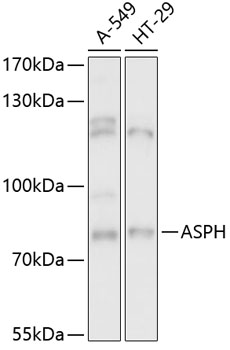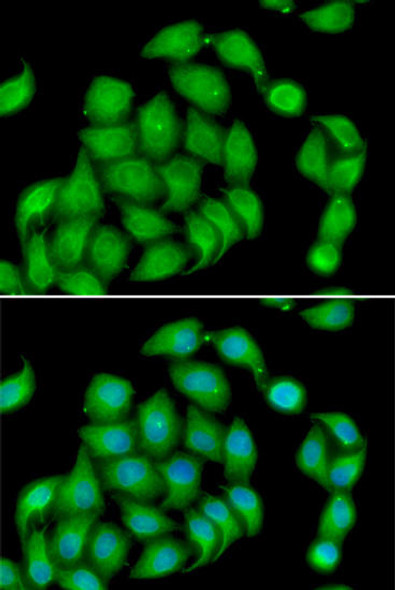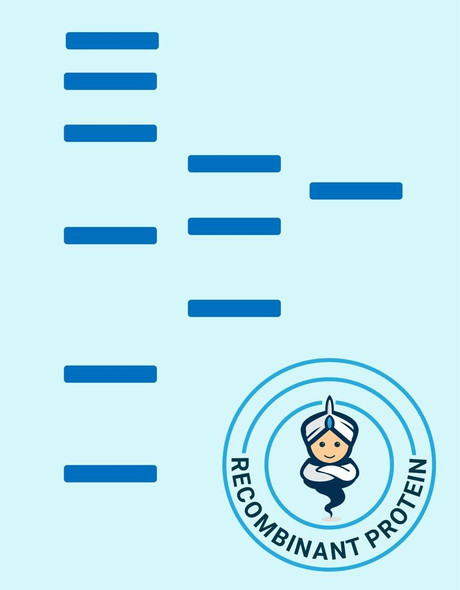Cell Biology Antibodies 3
Anti-ASPH Antibody (CAB13153)
- SKU:
- CAB13153
- Product Type:
- Antibody
- Reactivity:
- Human
- Host Species:
- Rabbit
- Isotype:
- IgG
- Antibody Type:
- Polyclonal Antibody
- Research Area:
- Cell Biology
Description
| Antibody Name: | Anti-ASPH Antibody |
| Antibody SKU: | CAB13153 |
| Antibody Size: | 20uL, 50uL, 100uL |
| Application: | WB IHC |
| Reactivity: | Human |
| Host Species: | Rabbit |
| Immunogen: | Recombinant fusion protein containing a sequence corresponding to amino acids 111-270 of human ASPH (NP_001158227.1). |
| Application: | WB IHC |
| Recommended Dilution: | WB 1:500 - 1:2000 IHC 1:50 - 1:100 |
| Reactivity: | Human |
| Positive Samples: | A-549, HT-29 |
| Immunogen: | Recombinant fusion protein containing a sequence corresponding to amino acids 111-270 of human ASPH (NP_001158227.1). |
| Purification Method: | Affinity purification |
| Storage Buffer: | Store at -20'C. Avoid freeze / thaw cycles. Buffer: PBS with 0.02% sodium azide, 50% glycerol, pH7.3. |
| Isotype: | IgG |
| Sequence: | ERST SEPA VPPE EAEP HTEP EEQV PVEA EPQN IEDE AKEQ IQSL LHEM VHAE HETE HSYH VEET VSQD CNQD MEEM MSEQ ENPD SSEP VVED ERLH HDTD DVTY QVYE EQAV YEPL ENEG IEIT EVTA PPED NPVE DSQV IVEE VSIF PVEE QQEV PPDT |
| Gene ID: | 444 |
| Uniprot: | Q12797 |
| Cellular Location: | Endoplasmic reticulum membrane, Sarcoplasmic reticulum membrane, Single-pass type II membrane protein |
| Calculated MW: | 21-34kDa/83-85kDa |
| Observed MW: | 86kDa |
| Synonyms: | ASPH, AAH, BAH, CASQ2BP1, FDLAB, HAAH, JCTN, junctin |
| Background: | This gene is thought to play an important role in calcium homeostasis. The gene is expressed from two promoters and undergoes extensive alternative splicing. The encoded set of proteins share varying amounts of overlap near their N-termini but have substantial variations in their C-terminal domains resulting in distinct functional properties. The longest isoforms (a and f) include a C-terminal Aspartyl/Asparaginyl beta-hydroxylase domain that hydroxylates aspartic acid or asparagine residues in the epidermal growth factor (EGF)-like domains of some proteins, including protein C, coagulation factors VII, IX, and X, and the complement factors C1R and C1S. Other isoforms differ primarily in the C-terminal sequence and lack the hydroxylase domain, and some have been localized to the endoplasmic and sarcoplasmic reticulum. Some of these isoforms are found in complexes with calsequestrin, triadin, and the ryanodine receptor, and have been shown to regulate calcium release from the sarcoplasmic reticulum. Some isoforms have been implicated in metastasis. |
| UniProt Protein Function: | ASPH: Isoform 1: specifically hydroxylates an Asp or Asn residue in certain epidermal growth factor-like (EGF) domains of a number of proteins. Belongs to the aspartyl/asparaginyl beta-hydroxylase family. 9 isoforms of the human protein are produced by alternative splicing. |
| UniProt Protein Details: | Protein type:Membrane protein, integral; Oxidoreductase; EC 1.14.11.16 Chromosomal Location of Human Ortholog: 8q12.1 Cellular Component: endoplasmic reticulum membrane; sarcoplasmic reticulum membrane; sarcoplasmic reticulum lumen; endoplasmic reticulum; integral to membrane; plasma membrane; integral to endoplasmic reticulum membrane Molecular Function:protein binding; electron carrier activity; structural constituent of muscle; calcium ion binding; structural molecule activity; peptide-aspartate beta-dioxygenase activity Biological Process: negative regulation of cell proliferation; peptidyl-aspartic acid hydroxylation; activation of store-operated calcium channel activity; muscle contraction; positive regulation of proteolysis; positive regulation of transcription, DNA-dependent; regulation of protein stability; regulation of inositol-1,4,5-triphosphate receptor activity; palate development; detection of calcium ion; limb morphogenesis; pattern specification process; response to ATP |
| NCBI Summary: | This gene is thought to play an important role in calcium homeostasis. The gene is expressed from two promoters and undergoes extensive alternative splicing. The encoded set of proteins share varying amounts of overlap near their N-termini but have substantial variations in their C-terminal domains resulting in distinct functional properties. The longest isoforms (a and f) include a C-terminal Aspartyl/Asparaginyl beta-hydroxylase domain that hydroxylates aspartic acid or asparagine residues in the epidermal growth factor (EGF)-like domains of some proteins, including protein C, coagulation factors VII, IX, and X, and the complement factors C1R and C1S. Other isoforms differ primarily in the C-terminal sequence and lack the hydroxylase domain, and some have been localized to the endoplasmic and sarcoplasmic reticulum. Some of these isoforms are found in complexes with calsequestrin, triadin, and the ryanodine receptor, and have been shown to regulate calcium release from the sarcoplasmic reticulum. Some isoforms have been implicated in metastasis. [provided by RefSeq, Sep 2009] |
| UniProt Code: | Q12797 |
| NCBI GenInfo Identifier: | 145559444 |
| NCBI Gene ID: | 444 |
| NCBI Accession: | Q12797.3 |
| UniProt Secondary Accession: | Q12797,Q6NXR7, Q8TB28, Q9H291, Q9H2C4, A6NDF4, A6NHI2 B4DIC9, B4E2K4, B7ZM95, E5RGP5, F5H667, |
| UniProt Related Accession: | Q12797 |
| Molecular Weight: | 758 |
| NCBI Full Name: | Aspartyl/asparaginyl beta-hydroxylase |
| NCBI Synonym Full Names: | aspartate beta-hydroxylase |
| NCBI Official Symbol: | ASPH |
| NCBI Official Synonym Symbols: | AAH; BAH; HAAH; JCTN; FDLAB; junctin; CASQ2BP1 |
| NCBI Protein Information: | aspartyl/asparaginyl beta-hydroxylase; humbug; junctate; A beta H-J-J; cardiac junctin; ASP beta-hydroxylase; peptide-aspartate beta-dioxygenase; aspartyl/asparaginyl-beta-hydroxylase |
| UniProt Protein Name: | Aspartyl/asparaginyl beta-hydroxylase |
| UniProt Synonym Protein Names: | Aspartate beta-hydroxylase; ASP beta-hydroxylase; Peptide-aspartate beta-dioxygenase |
| Protein Family: | Aspartyl/asparaginyl beta-hydroxylase |
| UniProt Gene Name: | ASPH |
| UniProt Entry Name: | ASPH_HUMAN |







